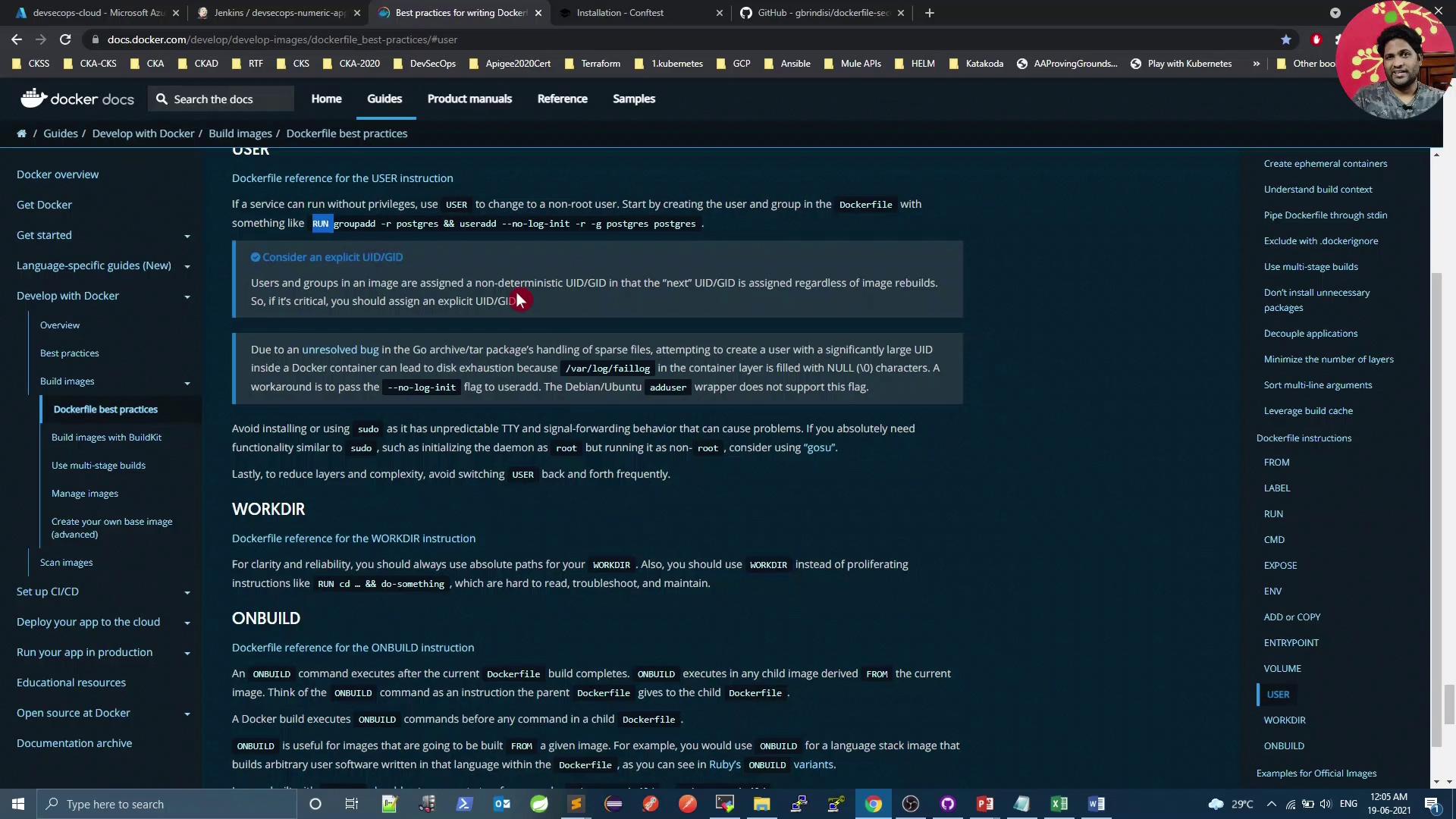DevSecOps - Kubernetes DevOps & Security
DevSecOps Pipeline
Demo OPA Conftest Docker
In this tutorial, we’ll show you how to automatically enforce Dockerfile security best practices using Open Policy Agent's Conftest. You’ll learn to:
- Review key Dockerfile guidelines
- Understand Kubernetes’ default container user
- Install and configure Conftest
- Write and run Rego policies against your Dockerfile
- Integrate policy checks into a CI/CD pipeline
- Remediate common security violations
Table of Contents
- Dockerfile Security Best Practices
- Default Container User in Kubernetes
- Installing OPA Conftest
- Writing Rego Policies
- Scanning a Dockerfile with Conftest
- CI/CD Integration
- Fixing Policy Violations
- Verifying the Fixes
- References
Dockerfile Security Best Practices
Follow Docker’s official guidelines to reduce vulnerabilities:
| Best Practice | Description | Example |
|---|---|---|
| Minimal base image | Use smaller images (e.g., Alpine) to reduce attack surface. | FROM alpine:3.15 |
| Pin image tags | Avoid floating latest tags. | FROM nginx:1.21.0 |
| Use COPY over ADD | Prevent unintended archive extraction or remote downloads. | COPY src/ /app/ |
| Non-root user | Create and switch to a non-root account. | USER appuser |
| Combine RUN steps | Limit image layers by chaining commands. | RUN apk add --no-cache curl && rm -rf /var/cache/apk/* |
| Secure ENV vars | Do not embed secrets in ENV. | Use runtime Kubernetes Secrets. |
Example: building a minimal BusyBox image
mkdir myproject && cd myproject
echo "hello" > hello
cat > Dockerfile <<EOF
FROM busybox
COPY hello /
RUN cat /hello
EOF
docker build -t helloapp:v1 .
Good vs. avoid:
# GOOD: simple file copy
COPY requirements.txt /tmp/
RUN pip install --requirement /tmp/requirements.txt
# AVOID if you just need to copy (adds unused tar extraction)
ADD https://example.com/big.tar.xz /usr/src/things/
To run as non-root:
FROM alpine:3.15
RUN addgroup -S appgrp && adduser -S appuser -G appgrp
WORKDIR /home/appuser
COPY app.sh .
USER appuser
CMD ["./app.sh"]

Default Container User in Kubernetes
By default, containers run as root in Kubernetes pods[^1]. Verify with:
$ kubectl get pods
NAME READY STATUS RESTARTS AGE
app-5d8f7f6c67-abcde 1/1 Running 0 10m
$ kubectl exec -it app-5d8f7f6c67-abcde -- id
uid=0(root) gid=0(root) groups=0(root),1(bin),2(daemon),...
Warning
Running containers as root increases risk of privilege escalation. Always switch to a non-root user in your Dockerfile.
Installing OPA Conftest
Conftest evaluates your Dockerfile against custom policies written in Rego.
Linux
wget \
https://github.com/open-policy-agent/conftest/releases/download/v0.24.0/conftest_0.24.0_Linux_x86_64.tar.gz
tar xzf conftest_0.24.0_Linux_x86_64.tar.gz
sudo mv conftest /usr/local/bin
macOS
brew install conftest
Windows (Scoop)
scoop install conftest
Note
Alternatively, use the official Docker image:docker pull openpolicyagent/conftest
Writing Rego Policies
Create a file opa-docker-security.rego containing rules like:
package main
# 1. Block secrets in ENV keys
secrets_env = ["passwd", "password", "secret", "key", "token", "apikey"]
deny[msg] {
input[i].Cmd == "env"
val = lower(input[i].Value)
contains(val, secrets_env[_])
msg = sprintf("Line %d: Potential secret in ENV key: %s", [i, input[i].Value])
}
# 2. Trusted base images only (no slash)
deny[msg] {
input[i].Cmd == "from"
count(split(input[i].Value[0], "/")) > 1
msg = sprintf("Line %d: Use a trusted base image", [i])
}
# 3. No 'latest' tags
deny[msg] {
input[i].Cmd == "from"
parts = split(input[i].Value[0], ":")
contains(lower(parts[1]), "latest")
msg = sprintf("Line %d: Do not use 'latest' tag for base images", [i])
}
# 4. Avoid curl/wget in RUN
deny[msg] {
input[i].Cmd == "run"
val = lower(concat(" ", input[i].Value))
matches = regex.find_all("(curl|wget)[^ ]*", val, -1)
count(matches) > 0
msg = sprintf("Line %d: Avoid curl/wget in RUN", [i])
}
# 5. No system upgrades in RUN
upgrade_cmds = ["apk upgrade", "apt-get upgrade", "dist-upgrade"]
deny[msg] {
input[i].Cmd == "run"
val = lower(concat(" ", input[i].Value))
contains(val, upgrade_cmds[_])
msg = sprintf("Line %d: Do not upgrade system packages in Dockerfile", [i])
}
# 6. COPY not ADD
deny[msg] {
input[i].Cmd == "add"
msg = sprintf("Line %d: Use COPY instead of ADD", [i])
}
# 7. Must switch from root
any_user { input[i].Cmd == "user" }
deny[msg] {
not any_user
msg = "Use USER to switch from root"
}
Scanning a Dockerfile with Conftest
Given Dockerfile:
FROM adoptopenjdk/openjdk8:alpine-slim
EXPOSE 8080
ARG JAR_FILE=target/*.jar
ADD ${JAR_FILE} app.jar
ENTRYPOINT ["java","-jar","app.jar"]
Run:
docker run --rm -v $(pwd):/project \
openpolicyagent/conftest test \
--policy opa-docker-security.rego Dockerfile
Output:
FAIL - Dockerfile - main - Line 3: Use COPY instead of ADD
FAIL - Dockerfile - main - Do not run as root, use USER instead
FAIL - Dockerfile - main - Line 1: Use a trusted base image
CI/CD Integration
Add a Conftest scan to your Jenkins pipeline:
stage('Vulnerability Scan - Docker') {
steps {
parallel (
'Dependency Scan': { sh 'mvn dependency-check:check' },
'Trivy Scan': { sh 'bash trivy-docker-image-scan.sh' },
'OPA Conftest': {
sh """
docker run --rm -v \$(pwd):/project \
openpolicyagent/conftest test \
--policy opa-docker-security.rego Dockerfile
"""
}
)
}
}
A Conftest failure will halt the pipeline and highlight policy violations.
Fixing Policy Violations
- Trusted base images – comment or adjust the rule if using a private registry.
- Replace
ADDwithCOPY. - Create and switch to a non-root user.
Adjusted Rego (disable trusted-base-image rule)
package main
# # Block untrusted base images
# deny[msg] {
# input[i].Cmd == "from"
# count(split(input[i].Value[0], "/")) > 1
# msg = sprintf("Line %d: Use a trusted base image", [i])
# ... other rules unchanged ...
Revised Dockerfile
FROM adoptopenjdk/openjdk8:alpine-slim
EXPOSE 8080
ARG JAR_FILE=target/*.jar
# Create non-root user
RUN addgroup -S k8s-pipeline \
&& adduser -S k8s-pipeline -G k8s-pipeline
# Copy artifact & switch user
COPY ${JAR_FILE} /home/k8s-pipeline/app.jar
USER k8s-pipeline
ENTRYPOINT ["java","-jar","/home/k8s-pipeline/app.jar"]
Commit and push your changes, then rerun the pipeline.
Verifying the Fixes
docker run --rm -v $(pwd):/project \
openpolicyagent/conftest test \
--policy opa-docker-security.rego Dockerfile
# 8 tests, 8 passed, 0 warnings, 0 failures, 0 exceptions
Deploy to Kubernetes and confirm non-root:
$ kubectl get pods
NAME READY STATUS RESTARTS AGE
app-7f9c5b4d8d-xyz12 1/1 Running 0 1m
$ kubectl exec -it app-7f9c5b4d8d-xyz12 -- id
uid=100(k8s-pipeline) gid=101(k8s-pipeline) groups=101(k8s-pipeline)
References
- Dockerfile Best Practices
- Kubernetes Security Context
- Open Policy Agent Conftest
- Rego Language Documentation
[^1]: Kubernetes inherit root privileges unless overridden by securityContext.
Watch Video
Watch video content